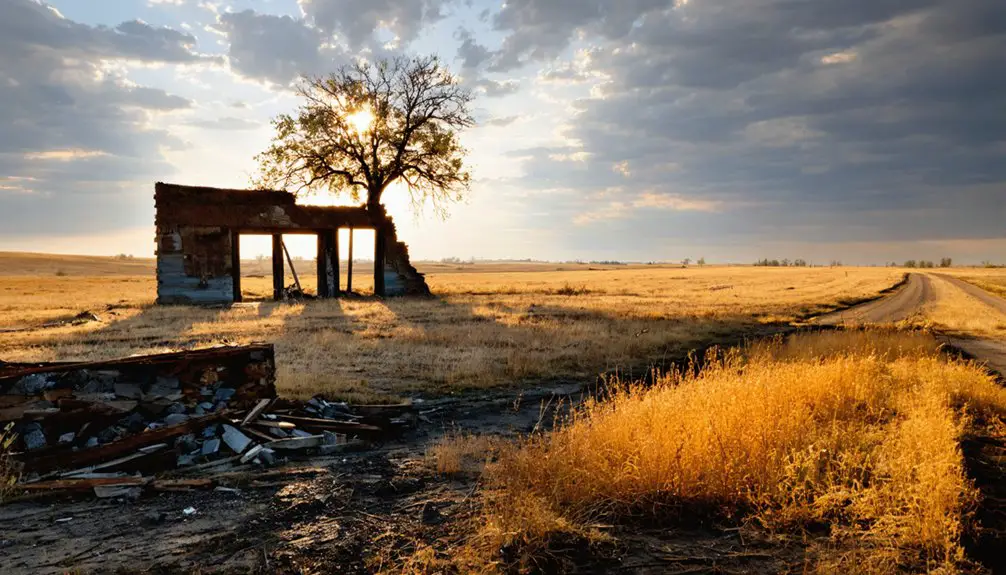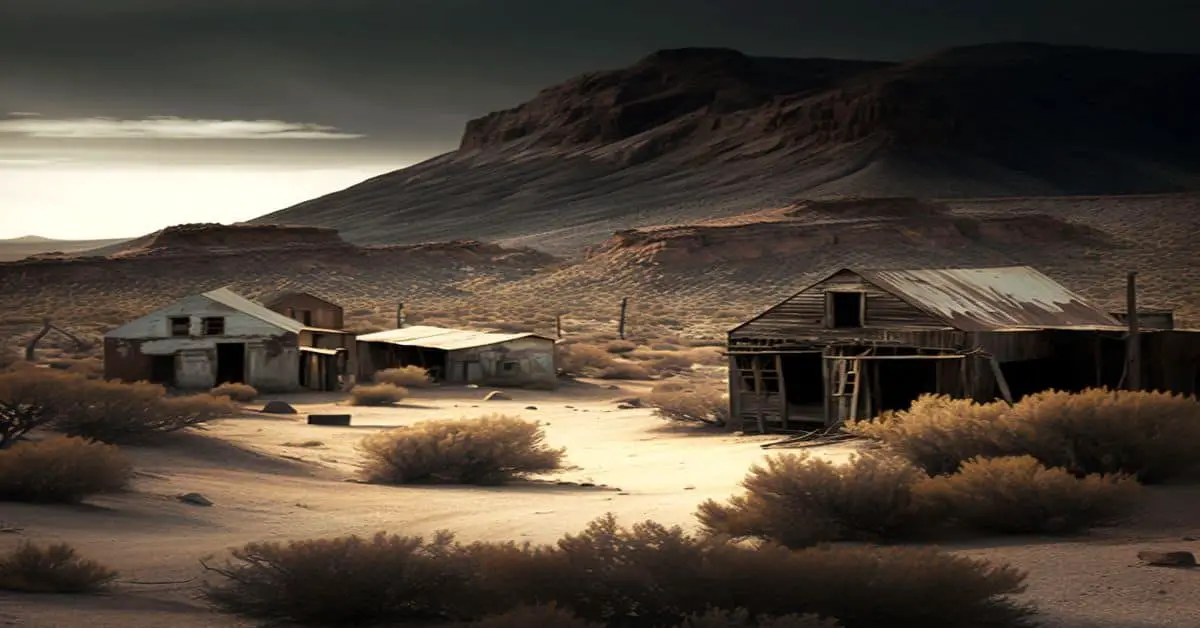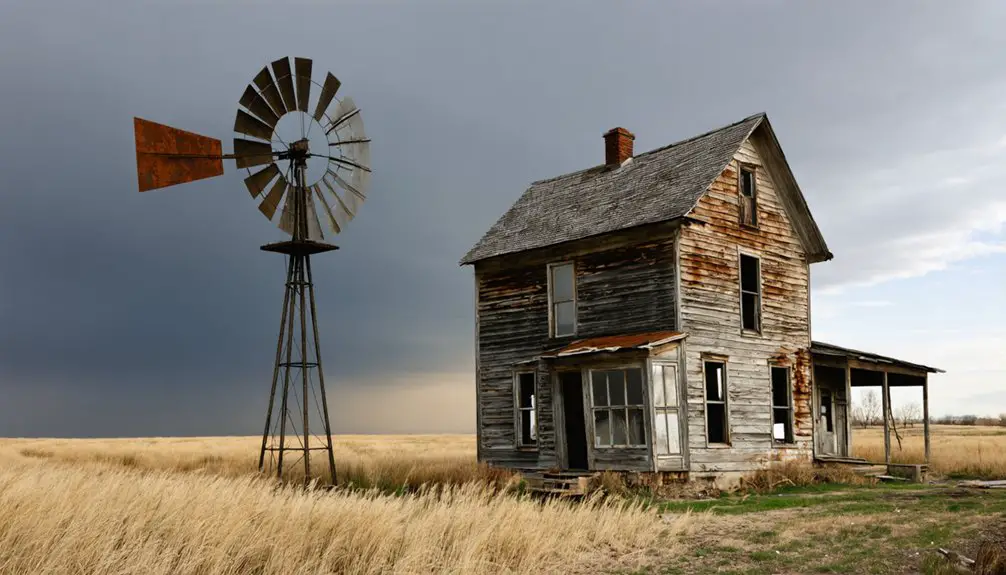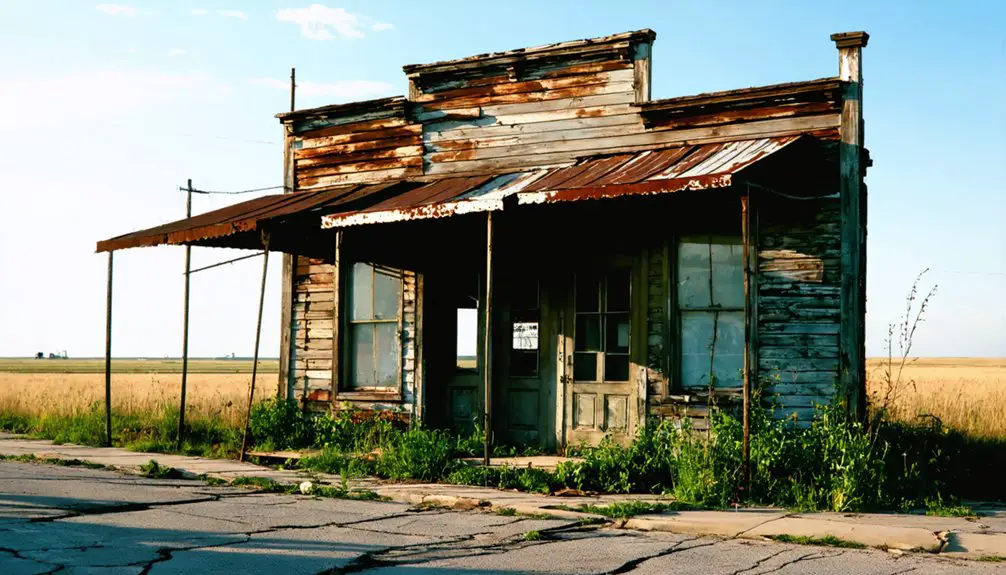You’ll find DeWitty’s traces in Nebraska’s Sandhills, where Black homesteaders built the state’s largest African American settlement in 1906. Under the Kinkaid Act, these pioneers claimed 640-acre parcels, establishing a thriving community of 150 residents across 56 homesteads. They constructed homes, schools, and businesses while fostering unprecedented racial harmony with neighboring ranchers. Though renamed Audacious in its later years, the town persisted until 1936, leaving behind a remarkable story of determination and achievement.
Key Takeaways
- DeWitty was Nebraska’s largest and longest-lasting Black settlement, established in 1906 and abandoned by 1936, becoming a ghost town.
- Located in Nebraska’s Sandhills, DeWitty peaked at 150-175 residents across 56 homesteads covering nearly 30,000 acres.
- The settlement included essential buildings like a church, store, post office, and three rural schools before its decline.
- Harsh environmental conditions and agricultural challenges in the semi-arid region contributed to the settlement’s eventual abandonment.
- Only historical markers in Cherry County remain today to commemorate where this once-thriving African American community existed.
The Birth of a Black Pioneer Settlement
When the Kinkaid Act of 1904 opened Nebraska’s Sandhills to homesteaders, it sparked the birth of DeWitty, one of the most significant Black settlements in the state’s history.
You’ll find that brave African American settlers, including former slaves and their descendants, claimed 640-acre parcels of this challenging semi-arid land, determined to build new lives of freedom.
The settler experiences were diverse, with many families arriving from Buxton, Ontario – a haven on the Underground Railroad – while others relocated from different Nebraska counties. The early settlers constructed homes from stacked sod to establish their homesteads. Unlike other Black settlements of the era, DeWitty residents experienced peaceful relationships with neighboring white ranchers.
By 1915, you’d have seen a thriving community of 150 to 175 residents who’d claimed 56 homesteads covering 29,402 acres.
These pioneers, representing a rich cultural heritage of African American and Irish-Canadian backgrounds, transformed the untamed Sandhills into a symbol of Black independence and determination.
Life on the Nebraska Sandhills
Life for DeWitty’s settlers meant adapting to the unique challenges of Nebraska’s Sandhills environment.
You’d find yourself surrounded by towering grass-covered dunes reaching heights of 400 feet, stretching across a landscape that rises gradually from 1,800 feet in the east to 3,600 feet in the west.
The Sandhills ecology demanded respect – you’d face extreme temperatures ranging from -40°C in winter to scorching 43.3°C in summer.
Yet, the region’s unique features offered opportunities too. You’d discover shallow lakes and streams fed by the massive Ogallala Aquifer below, while mixed-grass prairies stabilized the sandy soil.
Beneath the Sandhills’ rugged surface lies nature’s hidden gift – the life-giving Ogallala Aquifer nourishing streams and sustaining prairie grasses.
The varied terrain created distinct microclimates: south-facing slopes stayed drier, while north-facing slopes retained precious moisture.
In the valleys and swales, you’d find more fertile soil for cultivation, though the region’s semiarid climate made farming particularly challenging.
Annual rainfall in this harsh landscape ranged from 23 inches eastward to less than 17 inches in the western portions.
Building Community Against All Odds
Despite the harsh realities of Sandhills living, DeWitty’s settlers built a remarkably cohesive community anchored by crucial infrastructure and strong social bonds.
You’ll find they constructed essential gathering places including a church, store, barber shop, and post office. They established three rural schools, prioritizing their children’s education even in remote conditions.
The community’s resilience shone through their social activities. They formed the North Loup Sluggers baseball team, hosted Independence Day rodeos, and organized picnics that brought together both Black settlers and white ranching neighbors. With a peak of 150 residents in 1915, these social activities helped unite the growing population.
These gatherings fostered unprecedented racial harmony during a time of national tension. You can see how their shared experiences and mutual support created lasting connections, even as they faced economic hardships and challenging farming conditions in their 640-acre homesteads. To supplement their income, many settlers found work as laborers on neighboring ranches while maintaining their own homesteads.
From DeWitty to Audacious: A Town’s Evolution
During its early settlement period from 1906 to 1908, the town of DeWitty took root in Nebraska’s challenging Sandhills region as Black homesteaders claimed 640-acre parcels under the Kinkaid Act.
You’ll find that these pioneers, including former slaves and Black Canadian immigrants, faced formidable settlement challenges as they built homes from stacked sod and worked the semi-arid land.
Despite harsh conditions, the community’s cultural resilience shone through as DeWitty grew into Nebraska’s largest and longest-lasting African American rural settlement. The settlers maintained peaceful coexistence with neighboring communities, particularly the white residents of nearby Brownlee.
The town later changed its name to Audacious, reflecting the bold spirit of its inhabitants. The settlement remained active until 1936, when declining agricultural conditions forced many residents to relocate.
Legacy of Nebraska’s Largest African American Settlement
The remarkable scale of DeWitty’s settlement stands as a tribute to African American homesteading achievements in Nebraska’s history. At its peak in 1915, you’d find 150 residents cultivating nearly 30,000 acres across 56 homesteads, making it the state’s largest Black settlement.
Despite agricultural challenges in the semi-arid Sandhills, DeWitty’s cultural heritage flourished through its church, schools, and community gatherings.
You’ll find stories of cross-racial harmony with neighboring white ranchers, baseball games, and joint Independence Day celebrations that defied era norms.
Though the last Black resident departed in 1936, DeWitty’s impact endures through historical markers in Cherry County.
The settlement’s 32-year existence showcases African American pioneers’ determination to build independent lives through land ownership, even in the face of harsh environmental conditions.
Frequently Asked Questions
What Happened to the Original Dewitty Post Office Building?
Lost in the sands of time, you won’t find records of the original post office’s fate. Post office history suggests the building wasn’t preserved, likely dismantled or left to decay after closure.
Did Any Dewitty Settlers Maintain Contact With Their Canadian Communities?
You’ll find settlers maintained active communication channels with Canadian communities through family letters, shared cultural exchange during gatherings, and continued migration patterns between regions throughout the late 1800s and early 1900s.
What Specific Crops Did Dewitty Farmers Attempt to Grow?
Like seeds scattered with hope, you’d find DeWitty’s farmers growing wheat as their main crop, alongside thriving strawberry fields and hardy squash, though corn production remained limited in the challenging Sandhills soil.
Were There Any Documented Marriages Between Dewitty Residents and Neighboring Communities?
You won’t find direct records of DeWitty marriages with neighboring communities in public archives, though family histories and migration patterns suggest connections existed between residents across nearby Nebraska towns and settlements.
How Did Dewitty Residents Access Medical Care in the Remote Settlement?
Like pioneers on the medical frontier, you’d face stark healthcare challenges without telemedicine options. You’d travel to neighboring towns, rely on community support, and use horses or wagons for emergency care.
References
- https://history.nebraska.gov/marker-monday-dewitty-an-african-american-settlement-in-the-sandhills/
- https://www.blackpast.org/african-american-history/dewitty-audacious-nebraska-1908/
- https://visitvalentine.org/places/dewitty-audacious/
- https://nebraskapublicmedia.org/en/series-media/nebraska-stories-video/season-8-video-15886/the-dewitty-settlement-50001881/
- https://www.youtube.com/watch?v=3dlvD1sOO04
- https://www.nps.gov/articles/000/forgotten-homesteads-the-prominent-african-american-homesteads-of-nicodemus-and-dewitty.htm
- https://nebraskaarchaeology.org/2017/10/02/archaeology-of-african-american-pioneers/
- https://www.britannica.com/place/Sand-Hills
- https://pubs.usgs.gov/pp/1120a-c/report.pdf
- https://en.wikipedia.org/wiki/Sandhills_(Nebraska)



